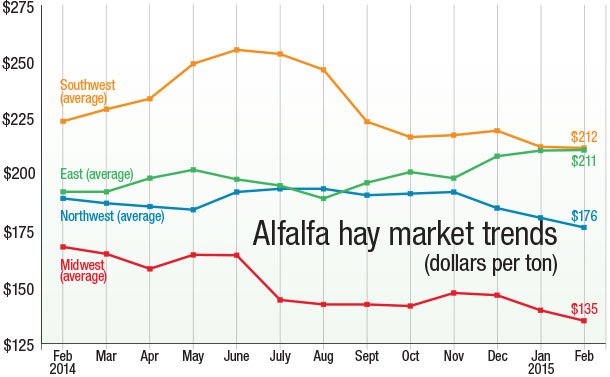Weather
According to the federal Weekly Weather and Crop Bulletin, a warm, dry spring has led to premature melting of mountain snowpack from California through the Intermountain West. The average water content of the high-elevation Sierra Nevada snowpack is less than 10 percent of normal for this time of year.
Generally dry conditions and warm temperatures stretched eastward across the northern Plains and much of the upper Midwest, following a nearly snow-free winter.
The U.S. seasonal drought outlook through June 30, 2015, shows persistent or intensifying drought through Oregon, California, Nevada, Utah, Arizona and the western edges of New Mexico, Colorado and Idaho.
International
Exports continued to drop through the fourth quarter of 2014, due in part to the longshoremen contract negotiations and issues with GMO testing in China. Although a longshoremen contract was finally reached in 2015, the ports are still backed up and exporters are having trouble locating empty shipping containers.
The U.S. Department of Commerce reports exports to the United Arab Emirates are at the lowest point in over seven years. The U.S. Census Bureau Trade Data reports all hay exports nationwide dropped by 9 percent from January 2014 (value of $84,036 in thousands of dollars) to January 2015 ($76,370 in thousands of dollars).
Top four hay export markets in January 2015:
- Japan – 90,870 metric tons
- China – 53,354 metric tons
- South Korea – 50,794 metric tons
- United Arab Emirates – 10,643 metric tons
Planting or harvesting progress
The week of March 16, there were reports of first-cutting alfalfa harvested in southern California and Florida. Producers in California have reported the start of irrigation on hay fields two to four weeks ahead of schedule due to dry conditions. If fair weather in the Northwest holds, first-cut hay harvest may be ahead of schedule by three weeks or more.
On March 31, USDA National Agricultural Statistics Service (NASS) released a prospective plantings report indicating intended area to be harvested in 2015 for all hay acres.
All-hay acres are expected to increase by only 1,000 acres nationwide. States with the largest gain in acreage included Missouri (up 220,000 acres) and Kansas (up 200,000 acres). States with the largest decrease in all-hay acres included Oklahoma (down 490,000 acres) and Minnesota (down 160,000 acres).
Charting hay market trends
Hay markets vary widely by region and by product: alfalfa hay versus “other hay.” This chart reflects monthly alfalfa hay market prices and information since February 2014, based on NASS data.
View a similar chart for "other hay." FG










